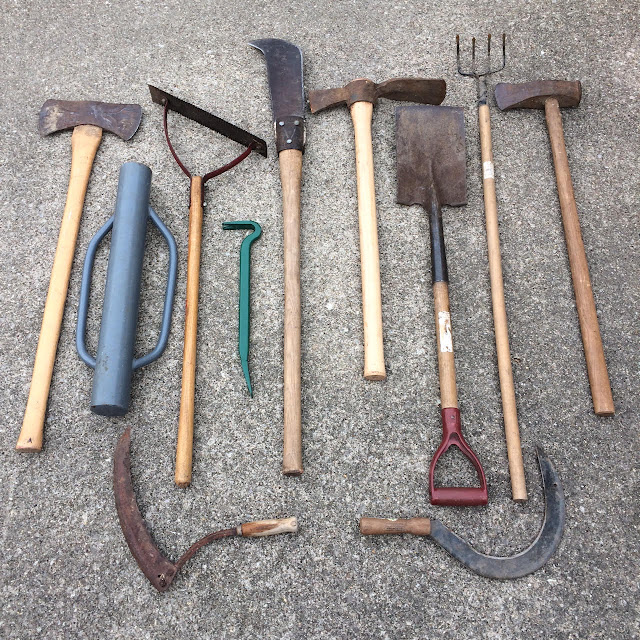 |
This first set is among our most used and well-cared for. They are all for the more delicate aspects of farming & gardening, requiring a more regular cleaning & oiling, and demanded secure protection from any of the elements we may subject them to. Tomahawks are great for simple bark stripping & branch splitting when stakes or borders are necessary, as well as some larger harvests & cleanups like brussels sprouts or epazote. Pruners best used for thinning berries & nightshades and harvesting okra, curcubits & kohlrabi. Kitchen knives, preferably a scimitar type, make great harvest knives for excellently clean slicing chops on bunches of greens and root tops. Nejiri-kama is hands-down the most versatile tool for crop maintenance, aiding almost any job necessary; specifically a massive technological triumph toward cultivation in it's ability to breeze thru clearing weeds. Hori Hori also easily garnishes high praise for how accessible & easy it makes transplanting & medicinal root harvesting. All sheaths are fashioned with belt straps to fit alongside a general purpose utility pouch, usually serving various cordage and towels. Another belt fitted with a traditional crust-punk ass-flag (or butt-flap, depending on your region or sensitivity), reinforced with PVC fabric & steel grommets, allows for necessary protection when sitting in unsavory conditions. As we choose to perceive our work in farms & gardens for the rise of an ancient matriarch, the reinforced canvas bag used to hold these tools is mostly just for fun kitsch.
Heavier work asks for bigger tools; many times done less often, leaving them with a regular need for cleaning. Double-bit Falling Axe for harvesting & barking timber & logs. Grass Whip and Brush Axe (easily my favorite two-handed cutter) makes leveling thick overgrowth an absolute breeze when clearing paths & borders. Good ol' fashioned heavy Mattock is another easy favorite and completely essential when breaking ground on new plots. Short-handled Flat Shovel to transfer loose medium churned up by a common Hand Cultivator when sheet-mulching. 8lb Maul almost exclusively for splitting firewood. Hand Scythe to clear overgrowth closer to crops & Sickle for harvesting grasses.
Some tasks at hand may not directly impact an interaction with soil or crops, but instead help support then to allow for easier growth. A simple collection of pliers & compound cutters to work with soft metals like wires & tin can erect structures to help trellis or shade, with hide gloves to avoid cutting or tearing skin. Mallet (usually rubber or dead blow) for driving posts or stakes and Measuring Tape for appropriate spacing. Since this set has a direct purpose, it was suitable to give it an exclusive belt system to help separate jobs & avoid overwhelming one's self with too many tasks at once or wasting time scouring through a grande cache.
With the temperate weather upon us, all of these tools will receive some level of cleaning & maintenance before a ceremonial Smoke Bath & their subsequent uses.
All Hail The Rabbit & Their Gift of Spring.
...

